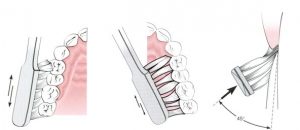One of my patients recently asked me if blogged about “tooth brushing” for adults, so I decided to write about tooth brushing techniques. I realized I am so focused about techniques in advanced dentistry that I forgot about some basics in oral health, assuming everyone knows about them.
Tooth Brushing Techniques:
Many methods have been described as being efficient & effective to clean your teeth. They are mainly categorized according to the hand motion while brushing. Examples are,
- Roll method
- Vertical method
- Horizontal or Scrubing method
- Vibratory method
- Circular method
Studies have not found any superiority among these methods as long as they are used properly. The goal of brushing is to remove plaque or biofilm from tooth surfaces as much as possible. So do not be focused how long you brush your teeth, but how clean they become when you are done. Also, it is best to floss after brushing to clean up what is left. Sometimes you will be surprised how much food particles are still between your teeth when you floss.
Areas not accessible with brushing (e.g. between the teeth, specially tight areas), need to be flossed. Brushing with powered/electric tooth brushes can be equally good, but in some instances better, especially for elderly persons or any others with compromised dexterity or difficulties in hand motion. All you need to do is to keep the head of the electric tooth brush where the gum meets the tooth at a 45 degrees angle, with light pressure, and the electric tooth brush does the rest.
Horizontal or Scrub technique is the most common and simplest technique, and is most appropriate for kids.
People with periodontal disease might benefit from a specific tooth brushing method, which I will describe below. It is important to have an individualized brushing method recommendation based on the periodontal status and oral hygiene patterns of each patient. This should be discussed with your dentist.
Vibratory Technique:
Place the head of a soft brush parallel with the chewing surfaces, with the brush head covering three to four teeth,
beginning at the last tooth in the upper jaw on the right side ( the starting point does not matter as long as you keep an order so you won’t skip any teeth by mistake).
Place the bristles where the gum meets the neck of the teeth, establishing an angle of 45 degrees roughly.
Exert gentle vibratory pressure, using short back-and-forth motions without dislodging the tips of the bristles.
This motion forces the bristle ends into the gingival sulcus area as well as partially into the interproximal embrasures.
The pressure should light on the gum, but you should feel that the tips of the bristles go under the gum. Move the brush approximately 15-20 short strokes in the same position (as if your hand vibrates, in a Giggle Wiggle motion, sometimes we call it, if it makes sense!).
This repeated motion cleans the tooth surfaces, concentrating on the apical third of the clinical crowns, the space between the tooth and the gum, as well as the space between the teeth, as far as the bristles can reach. Lift the brush, move it to the adjacent teeth, and repeat the process for the next three teeth. Continue around the upper jaw on the outer surfaces brushing about three teeth at a time, then use the
same method to brush the inner surfaces. After completing the upper jaw, move the brush to the lower jaw and brush in the same manner until all teeth have been brushed. It is OK to brush the chewing surfaces in scrubbing motion. Chewing surfaces are the most common area for cavities to occur.
A ‘clean tooth’, i.e. one that is completely free of plaque, will not decay. However, very few individuals can ever completely remove plaque themselves, even under supervision. Hence, periodic dental/oral exam matters. Be mindful that Oral hygiene alone, without dietary advice and periodic fluoride application, may not be enough to prevent cavities. See your dentist regularly to prevent potential problems.
Regular dental visits are important to maintain oral health. Ask your dentist questions that help you to maintain health, and minimize potential risks.
If you have any comments or questions, please do not hesitate to ask me. 🙂
